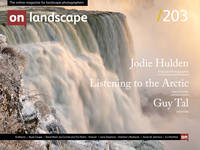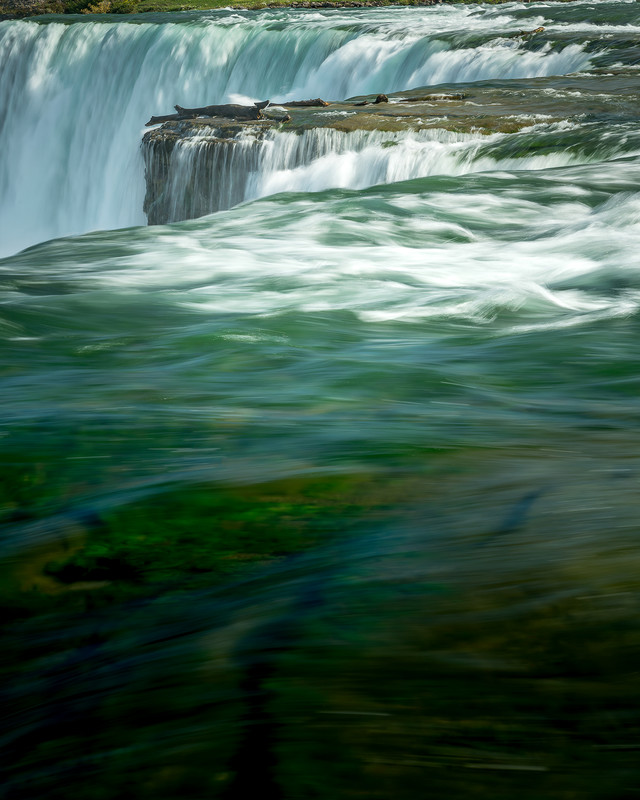Get more out of a location than just the standard iconic images

James M. Johnston
I am a photographer based in western New York state (Buffalo, Niagara Falls). My primary focus is nature and landscape, with a documentary lean for wildlife and the beauty of the natural world that we need to protect. Much of my work is centered around western New York and Southern Ontario, Canada with portfolio projects in progress on the beauty of our National and State Park Systems.
We all get excited when an opportunity arises for a trip to somewhere special for photography. The chance to photograph something new and fresh excites the mind. Let’s face it however unless you are able to afford the costs and time for these trips, they are not a regular opportunity. Most often we settle for what is within a short distance of our home. How do you stay “fresh” and enthusiastic, at the same time making imagery that is of a high personal standard that others will appreciate and find meaningful as well?
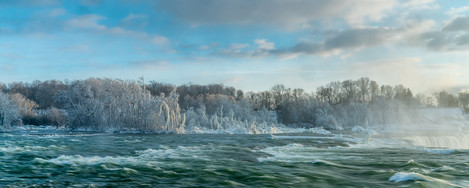
Niagara Panorama
Frozen mist from the falls coats the trees and shoreline of Goat Island just above Niagara Falls in this winter panorama of the river.
Most of us have a specific location that we choose to visit and photograph over and over. For some that location may be a destination such as a national park or a city. Others like myself may be fortunate enough to have such a location near to us. Having local access to a location allows us to photograph in a variety of seasons, light and weather conditions. But how do you take advantage of this, getting more than the standard “iconic” shots and personalising your portfolio of work? This is what I call “Capturing The Essence” of a location, taking images that represent the feeling of the place through detail and action shots.
I am fortunate to live within ten minutes of Niagara Falls, in western New York State. This is truly one of the natural wonders of the world. It is also one of the most visited and photographed natural parks, being located on the border between the United States and Canada, an hour and a half from Toronto, Canada and a half hour from Buffalo, NY. This makes it a year round tourist attraction and sometimes difficult to photograph without jostling with tourists. With all of my gear, I am frequently stopped and asked to take family photos with various phones and cameras, making it a wonder I get any photography of my own accomplished. Niagara Falls changes with the seasons as well as a time of day and weather conditions.
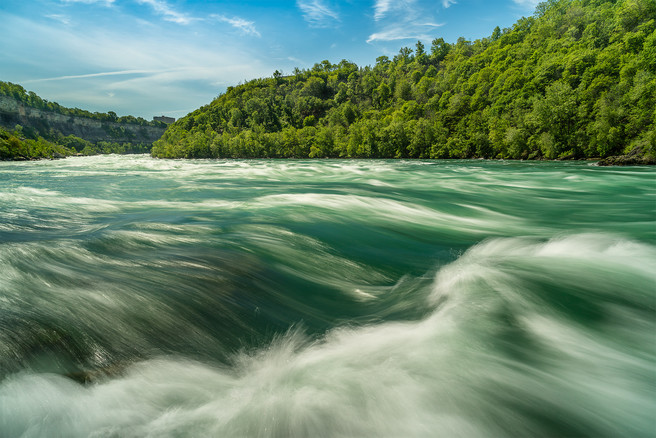
Whirlpool Rapids
The rapids leading into the Whirlpool State Park area of the Lower Niagara River. Accessed from a trail that runs down the face of the gorge and along the river, this location is a popular area for hikers. There are numerous trails that access both the US and Canadian sides of the gorge.
When I mention Niagara Falls I am sure that a picture instantly springs to mind. We have all seen the standard iconic images of Niagara Falls a thousand times. If not, just Google the park and you will see a screen full of nearly identical images. I have a number of these in my portfolio as well because they sell, but I strive as well to capture images of the park that are original and representative of how the park makes me feel in the moment. If these shots are meaningful to me then they hopefully will have a similar effect of others. When you have the luck of being able to see a location in many different conditions you begin to see things like autumn leaves on the ground in Zion, rock formations, animals, etc. that are specific to that location and have just as much emotional value as the iconic shots. Grand sweeping vistas are wonderful but sometimes the more intimate images convey as much emotion as the wide angle shots. Having a body of work that is singular and representative of your vision will set you apart from others, demonstrating your compositional and story-telling skills.
Niagara Falls is so much more than a huge waterfall. The Niagara River is a very large river connecting two of the Great Lakes. The upper river is wide and flat as it flows from Lake Erie, and the lower river is narrow, powerfully rapid, and passes through a gorge before emptying into Lake Ontario. The water at the Falls is a beautiful blue-green, due to minerals picked up off the rocks below. There are wondrous rapids that dance with the power of so much water moving through the narrow lead up to the falls. Below the majestic waterfalls, begins an entirely different world. The deep and narrow nature of the river below the falls makes for rapids and whirlpools that race through the first half of the deep Niagara gorge, before slowing as the river once again widens.
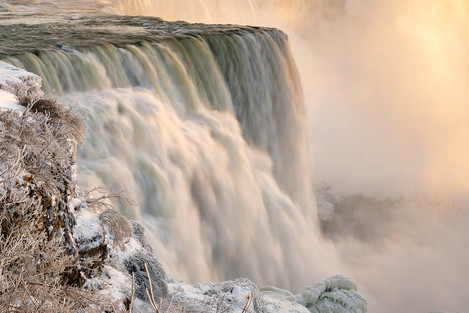
Winter’s Strength
The American Falls up close in winter. This late afternoon image had so many soft colours throughout, from the warm light of the setting sun, the magenta light of the falls lighting that had just come on, and the soft green colours of the water's sediment. I love how the ice builds over time, causing constantly changing sculptural formations on the rocks and plants.
In the spring and summer, everything is surrounded by lush green plant life and the sun glints off of the moving waters. Autumn brings variable skies and changing colours as the oaks and maples lose their leaves for the coming winter. Niagara Falls in the winter is like a crystal fairyland as snow and ice coat everything around falls. The rising mist from the waterfalls coats everything, both natural and man made. The longer the freezing cold lasts, the thicker the ice builds up. Additionally, because the river doesn’t freeze, we are blessed with migrating ducks, geese, Tundra Swans and a variety of gulls that winter here. This makes the area a hot spot for birders, year round.
With such a variety of changing conditions, I never lack compositional opportunities. Additionally, seeing a spot that might offer possibilities under different conditions is easily noted for future visits. Travelling to other national parks around the country means accepting the conditions found during that window of travel. Lady luck combined with advance prep work will get you great images, but you get what you get.
I try to make at least two trips during the year to other areas so I know how it is to come away with just average images. I am both a landscape and wildlife photographer, so my chances of finding interesting subjects are better. I always take notes and iPhone images to keep track of interesting spots for future trips. In the end, though, nothing beats having the source in your “backyard”. Keep an open mind and finding fresh images that keep you from losing sight of the changing beauty and impact of your local spot will always be there for you.
-
Turquoise & Gold
The turquoise waters of the Niagara River Rapids at Niagara Falls, offset by the orange warmth of the morning sun as it rises above the horizon. Christmas eve morning at Niagara Falls State Park, NY. I loved the bookended gulls on the log.
-
Strength – Summer
These two images were taken in the same location above the falls. This rock never moves and during the summer has plants and moss growing on it, making for an interesting study of the water moving around it. 1/6th of a second is perfect for moving water and texture here.
- Soft Niagara Sunrise sunrise view of the Horseshoe-Canadian side of Niagara Falls. The colours were brilliant as there wasn’t a cloud in the sky and the sun was nicely diffused by the rising mist. I know this shot is probably a very cliche view of the Falls but it never ceases to impress. Every visit is different.
-
Winter
These two images were taken in the same location above the falls. This rock never moves and during the summer has plants and moss growing on it, making for an interesting study of the water moving around it. 1/6th of a second is perfect for moving water and texture here.
-
Niagara Panorama
Frozen mist from the falls coats the trees and shoreline of Goat Island just above Niagara Falls in this winter panorama of the river.
- Whirlpool Rapids The rapids leading into the Whirlpool State Park area of the Lower Niagara River. Accessed from a trail that runs down the face of the gorge and along the river, this location is a popular area for hikers. There are numerous trails that access both the US and Canadian sides of the gorge.
-
Over The Edge
Waters rush over the edges of the American Falls at Niagara Falls State Park.
-
Niagara River Rapids #5
Number five in a series of Autumn images taken at Niagara Falls State Park in western New York. The focus of these images is on the flow of water and it’s interaction with the land.
-
Winter’s Strength
The American Falls up close in winter. This late afternoon image had so many soft colours throughout, from the warm light of the setting sun, the magenta light off the falls lighting that had just come on, and the soft green colours of the water’s sediment. I love how the ice builds over time, causing constantly changing sculptural formations on the rocks and plants.

